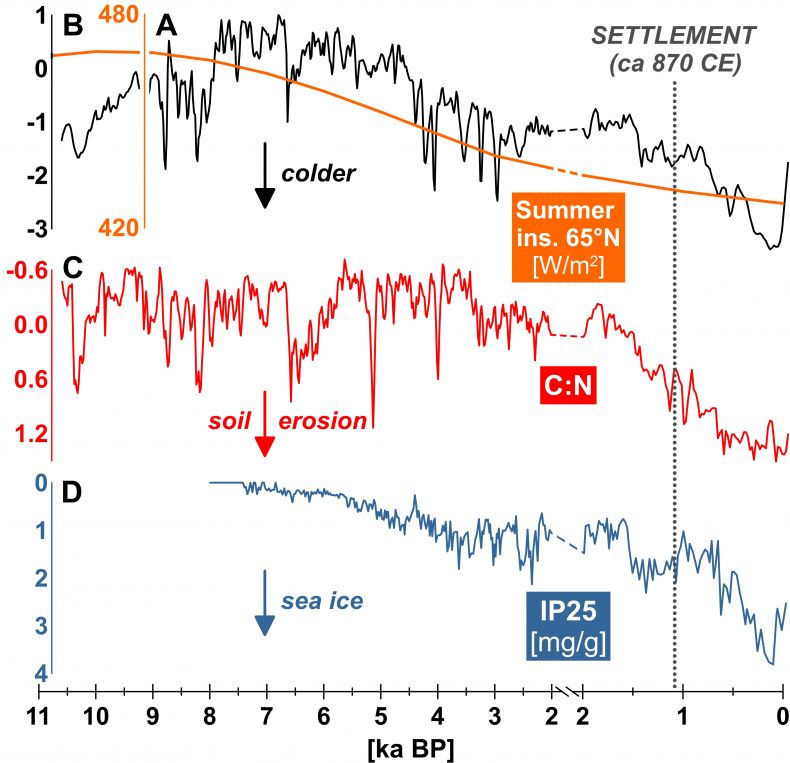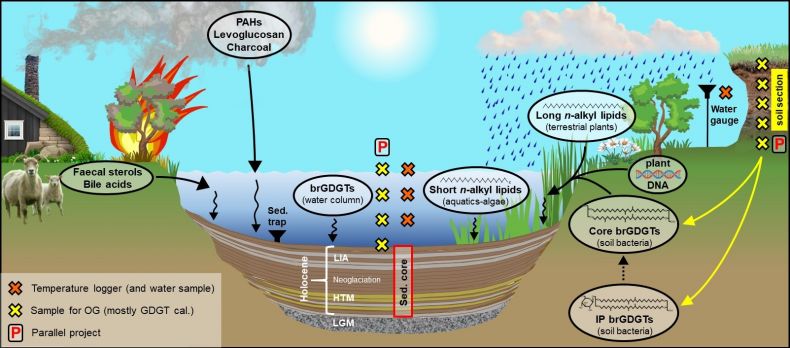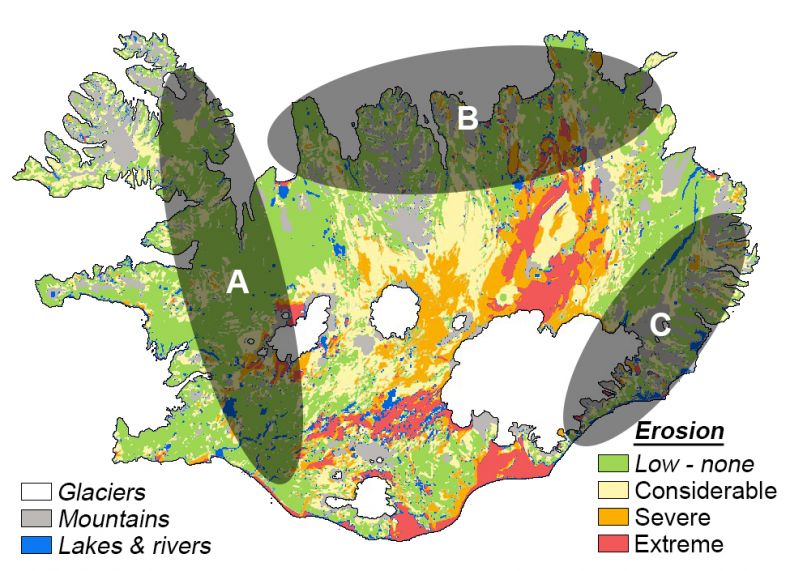The author(s) will give a talk
Disentangling the evolution of Holocene climate, soil erosion and human impact in Iceland
1 INSTAAR
2 INSTAAR
3 INSTAAR
4 INSTAAR
5 University of Iceland
6 INSTAAR
7 University of Iceland
The Arctic is warming twice as fast as the global average, with mean summer temperatures predicted to be 4–6°C higher than in the late 20th century by year 2100. In order to inform policy, predictive models rely on the understanding of climatic factors and feedback mechanisms. However, while large uncertainties remain, they can be reduced through the study of past climate evolution.
Soil erosion has been severe across Iceland for centuries and it is commonly thought to have been initiated at settlement (~870 CE; Dugmore et al., 2009). However, the roles of time (soil development), climate (mainly summer temperature), volcanism, and human impact (mostly settlement along with pastoral activity) as the cause of the widespread soil erosion, remains debated.
Twenty thousand years ago, Iceland and its shallow continental shelf lay beneath an independent ice sheet. As Iceland deglaciated (after 15 ka BP), plants colonised from distant sources and soil formed and developed (e.g., Geirsdóttir et al., 2020). By ~5 ka BP, the cooling caused by the decreasing northern hemisphere summer insolation (Fig. 1 A-B) resulted in the decline of birch woodlands, increased catchment soil erosion during colder summers, and regrowth or expansion of Iceland’s cryosphere (Neo-glaciation), with ice caps reaching maximum dimensions during the Little Ice Age (~1250-1850 CE). Though the primary forcing for Northern Hemisphere Holocene cooling is thought to be the monotonic decline in summer insolation, high-resolution records of environmental change indicate that Iceland's landscape response was non-linear (Fig. 1 B; Geirsdóttir et al., 2019, 2020).
Our ongoing project at INSTAAR aims to accurately reconstruct a continuous history of climate across Iceland since the last glacial period (~11.5 ka BP), and determine to what extent climate, volcanism and/or humans (Norse settlement) led to the widespread soil erosion, a pervasive feature of the contemporary Icelandic landscape.
We will rely on a novel integration of a rich archive of lipid biomarker proxies and sedimentary DNA (Fig. 2) obtained through downcore analysis of a series (3-5) lacustrine sediment cores. These are securely dated, high-resolution records spanning the entire Holocene and covering (Fig. 3) the western (A), the northern (B), and the south-eastern (C) coastal sectors of Iceland. The proxies we plan to use are brGDGTs (bacterial membrane lipids) for paleo-temperature; algae/plant waxes n-alkyl compounds, with their stable isotopic composition (delta²H, delta¹³C) for paleo-hydrology; and faecal sterols/bile acids and fire markers (polycyclic aromatic hydrocarbons, levoglucosan, and possibly charcoal) for human presence/agency. SedaDNA analysis will provide information on the evolution of the vegetation cover in the Icelandic landscape throughout the Holocene, with a focus on the deglaciation process, avoiding the shortcomings of pollen aeolian transport from more southern regions.
Additionally, interpretation of these proxies will be bolstered by the results of a parallel analysis of tephra layers (providing secure chronology, along with radiocarbon) and other organic/inorganic proxies (e.g., biogenic silica) tracing the evolution of volcanism and primary productivity.
Arnalds, O., Thorarinsdottir, E.F., Metusalemsson, S., Jonsson, A., Gretarsson, E., Arnason, A., 2001. Soil Erosion in Iceland. Soil Conservation Service. Agricultural Research Institute, Reykjavik, Iceland.
Berger, A., Loutre, M.-F., 1999. Parameters of the Earths orbit for the last 5 Million years in 1 kyr resolution. Supplement to: Quat Sci Rev 10.4: 297–317. doi:10.1594/PANGAEA.56040
Cabedo-Sanz, P., Belt, S.T., Jennings, A.E., Andrews, J.T., Geirsdóttir, Á., 2016. Variability in drift ice export from the Arctic Ocean to the North Icelandic Shelf over the last 8000 years: A multi-proxy evaluation. Quaternary Science Reviews 146, 99–115. doi:10.1016/j.quascirev.2016.06.012
Dugmore, A.J., Gisladóttir, G., Simpson, I.A., Newton, A., 2009. Conceptual Models of 1200 Years of Icelandic Soil Erosion Reconstructed Using Tephrochronology. Journal of the North Atlantic 2, 1–18. doi:10.3721/037.002.0103
Geirsdóttir, Á., Harning, D.J., Miller, G.H., Andrews, J.T., Zhong, Y., Caseldine, C., 2020. Holocene history of landscape instability in Iceland: Can we deconvolve the impacts of climate, volcanism and human activity? Quaternary Science Reviews 249. doi:10.1016/j.quascirev.2020.106633
Geirsdóttir, Á., Miller, G.H., Andrews, J.T., Harning, D.J., Anderson, L.S., Florian, C., Larsen, D.J., Thordarson, T., 2019. The onset of neoglaciation in Iceland and the 4.2 ka event. Climate of the Past 15, 25–40. doi:10.5194/cp-15-25-2019

Fig 1.
(A) Summer insolation at 65°N (Berger and Loutre, 1999). Iceland 7-lake composite records: (B) Holocene relative summer temperature, (C) C:N (Geirsdóttir et al., 2019). (D) IP25 (sea ice) on the north shelf of Iceland (MD99-2269) (Cabedo-Sanz et al., 2016).

Fig 2.
Schematic illustration of our field sampling-instrumentation strategies.

Fig 3.
Modern soil erosion in Iceland (modified from Arnalds et al., 2001). Black shaded areas indicate the three main regions (A-western, B-northern, and C-south-eastern coasts) covered by our lacustrine archives.